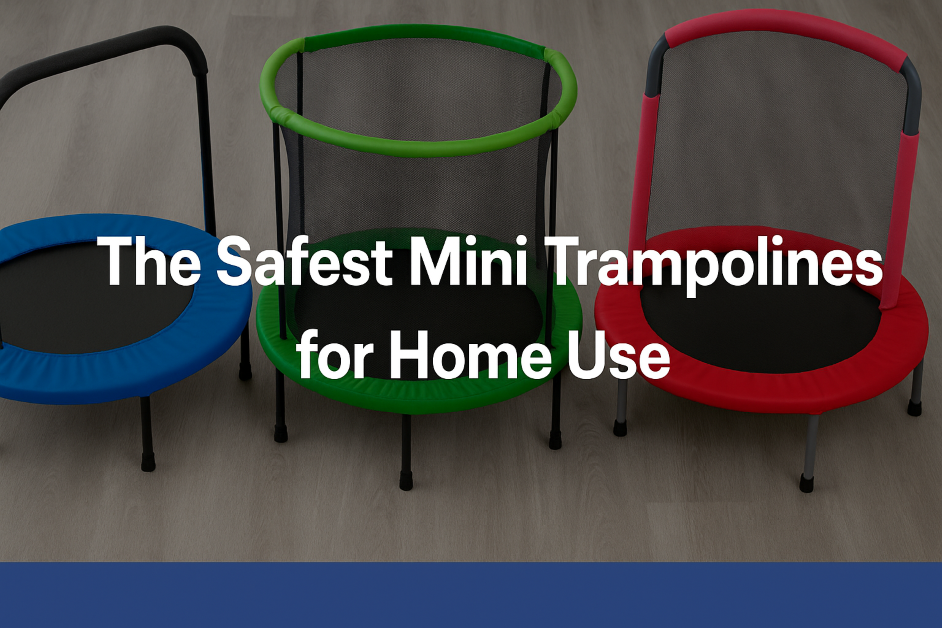
Best Safe Mini Trampolines
Mini trampolines are brilliant fun – until someone ends up with a sprained ankle. The best safe mini trampolines? Sturdy frames, padded edges, strong nets. Keep reading to find out which trampolines keep little daredevils bouncing safely (and your nerves intact).
Why Safety Matters in Mini Trampolines
Picture this: your little whirlwind bouncing away, giggling as they soar into the air. Meanwhile, you’re flinching every time they land near the edge, hoping they don’t take a tumble.
We all want our kids to burn energy and build confidence. But no one wants an afternoon of fun ending in an emergency room dash.
That’s why safety isn’t just a bonus when it comes to trampolines – it’s the deal-breaker. The right mini trampoline channels that wild energy into safe, focused fun. Kids get freedom. Parents get peace of mind.
Let’s look at what makes a trampoline truly safe.

Understanding Common Risks & Injuries
It’s not about being paranoid—it’s about being prepared. Common trampoline mishaps include falls from the frame, bumps on uncovered springs, or wild leaps that land off-target.
We’ve all heard horror stories: a toddler tumbles off the side, or a curious jumper gets a foot stuck in a spring. That’s why having proper padding, secure enclosures, and a stable base isn’t optional—it’s essential.
Getting clued up on these risks helps you make smarter choices before you buy.
The Importance of Certifications and Standards
Not all trampolines are created equal. Some might look great in photos but fail safety tests in real life.
Look out for models that meet safety certifications like the EN71 standard. It’s a good sign that the trampoline has been tested for stability, toxic materials, and proper construction.
If a brand doesn’t shout about its safety standards—there’s probably a reason.

Key Safety Features to Look For
When choosing a trampoline, don’t be swayed by bright colours or cartoon characters. The real magic is in the details—the kind that protect your child while they bounce away.
Frame Stability & Construction
Think of the frame as the skeleton of the trampoline. If it’s wobbly or poorly welded, you’re just asking for trouble.
Look for trampolines made from galvanised steel—these resist rust and last longer. A strong base and rubber-tipped legs also keep the trampoline from sliding across hard floors or sinking into soft garden turf.
Whether it’s in the lounge or on the lawn, you want it rock solid.
Mat & Spring/Bungee System Protection
The jumping mat and springs take all the action—so they need to hold up. Spring-free designs like the JumpKing Junior reduce pinch risks, while others use thick spring covers for added safety.
Bungee cords are another option—they're softer, quieter, and often found on indoor rebounders. But whether you go spring or bungee, make sure everything’s padded and securely stitched.
This isn’t just about comfort—it’s about avoiding scraped knees and stubbed toes.
Handlebars and Enclosures
For toddlers or nervous first-timers, handlebars offer that bit of extra support—like training wheels for bouncing. Safety enclosures are equally vital for older kids, keeping them from flying off the side mid-jump.
A good net should be high enough to catch a wild bounce and strong enough to handle the impact.
If it feels flimsy or awkward to zip up, it’s not the one.

Final Thoughts
Mini trampolines aren’t just toys—they’re little launching pads for health, happiness, and childhood memories. When chosen wisely, they give your child freedom to move and grow while keeping you free from worry.
Remember: look beyond the bright colours. A sturdy frame, padded edges, and strong netting are what really count.
So, whether it’s rainy-day bouncing in the lounge or summer fun in the garden, the right trampoline can keep your kids safe and smiling for years to come.
Ready to find your perfect fit? Let’s get bouncing.
Have you checked out our other posts?



Leave a comment